A History of the County of Worcester: Volume 3. Originally published by Victoria County History, London, 1913.
This free content was digitised by double rekeying. All rights reserved.
'Parishes: Wichenford', in A History of the County of Worcester: Volume 3(London, 1913), British History Online https://prod.british-history.ac.uk/vch/worcs/vol3/pp561-566 [accessed 25 April 2025].
'Parishes: Wichenford', in A History of the County of Worcester: Volume 3(London, 1913), British History Online, accessed April 25, 2025, https://prod.british-history.ac.uk/vch/worcs/vol3/pp561-566.
"Parishes: Wichenford". A History of the County of Worcester: Volume 3. (London, 1913), British History Online. Web. 25 April 2025. https://prod.british-history.ac.uk/vch/worcs/vol3/pp561-566.
In this section
WICHENFORD
Wychynford (xiv cent.); Wychenford (xvi cent.); Winchenford, Whichingford, Witchenford (xvii cent.); Wickingford, Wickenford (xviii cent.).
The parish of Wichenford lies 6 miles to the north-west of the town of Worcester. Its area is 2,866 acres, (fn. 1) of which in 1905 656 acres were arable land, 1,761 permanent grass and 119 woods. (fn. 2) The soil is clay, with a subsoil of Keuper Marl, growing crops of wheat, beans and fruit and a few hops. The slope of the land is from north-west to south-east, the highest point, 363 ft. above the ordnance datum, being in the extreme north-west.
The road from Martley to Worcester runs through the middle of the parish, and from it another road branches off to the hamlet of Wants Green in the south, and forms part of the western boundary of the parish. From Wants Green it runs south-east, and forms part of the southern boundary, being joined at Tinkers' Cross by a branch road. From Castle Hill on the Worcester road another road runs north-east to the village of Wichenford.
Laughern Brook, flowing east to join the River Teme near Powick, divides the parish into two parts, and is crossed at Pig Bridge by the Worcester road. To the south of the bridge there are fish ponds (fn. 3) and a weir. Woodhall Farm (fn. 4) and Woodend Farm lie still further south, and at both there are the remains of moats. The village of Wichenford is situated on the eastern boundary of the parish on the banks of Laughern Brook.
A quarter of a mile south-east of the church is Wichenford Court, formerly the residence of the Washbournes, when it was one of the largest mansions in the county and had a moat and drawbridge. (fn. 5) It was evidently to a great extent rebuilt about 1712, and at one time covered more space than it does now. (fn. 6) By 1866 it was only a farm-house, (fn. 7) but the remains of the moat are still in existence. The present house is in the main a red brick building of about 1700, with wood mullioned and transomed windows and leaded lights with good wrought-iron fasteners. The east room on the first floor contains early 17th-century panelling and a plain but good carved mantel. The middle room on this floor is also panelled, and has a carved frieze, used as a skirting board, all now painted. The stair has good 18th-century balusters. Among the farm buildings is a fine timber and wattle barn put up in 1695. There is also near the house a half-timber dovecote on a red sandstone base, surmounted by a glazed lantern.
When Wichenford Court was visited by the Worcestershire Naturalists' Club on 7 June 1866, around two sides of a panelled room under the ceiling were a number of carved grinning heads with teeth, said to be human. (fn. 8) The tradition is that during the wars with the Welsh under Owen Glendower in the reign of Henry IV one of the Bourbon princes was confined here for some time, and was afterwards put to death by the then Lady Washbourne. After her death her ghost, with a dagger in its hand, is said to have been seen in the murdered prince's chamber. (fn. 9) This tale was later connected with an old portrait of one of the Washbournes. The ghost of Lady Washbourne, wife of John the Royalist, is said to frequent the moat with a golden harp, in a silver boat drawn by four white swans. (fn. 10) To the south of Wichenford Court is Abbinton's Farm, the old manor-house of the Habington family. Most of the house was taken down in the 18th century, and the remaining portion was converted into a couple of cottages about 1865. (fn. 11)
Two Roman coins of the time of Victorinus and Constans have been found in Wichenford. (fn. 12)
There is no Inclosure Act for Wichenford. In 1884 Ossage Farm was transferred from the parish of Cotheridge to that of Wichenford. (fn. 13)
Among the place-names that have been found are the Lady Meadow, the Tineing, the Upper and Lower Hassells Meadow and the Malenders (fn. 14) (xvii cent.), and Coldbrook, Ockeridge Waste, Rugg's Place and Bournescroft (xix cent.).
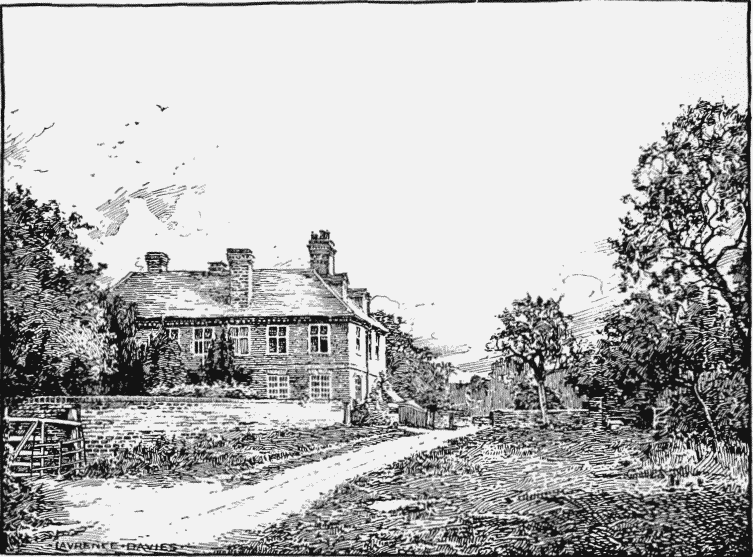
Wichenford Court
MANORS
The manor of WICHENFORD was no doubt included at the time of the Domesday Survey in that of Wick Episcopi belonging to the see of Worcester. It continued to form part of the latter manor until the 16th century, for in a commission taken in 1594–5 it is stated that 'the manors of Wike Episcopi and Wichingforde were the same manor of Wike Episcopi and had the same court baron until the manor of Wike Episcopi came to the hands of the king.' (fn. 15) This probably refers to the confiscation of the manor by Edward VI, (fn. 16) but Habington assigns the date of the severance of the two manors to the beginning of the reign of Queen Elizabeth, when Wick Episcopi passed by exchange to the queen. (fn. 17) Walter Cantilupe, Bishop of Worcester, claimed to be lord paramount at Wichenford, (fn. 18) and in 1288 Bishop Giffard granted land there to one Matthew Choke. (fn. 19) In 1535 the manor of Wichenford belonging to the bishop was valued apart from that of Wick Episcopi. (fn. 20)
In 1552 Bishop Nicholas Heath was deprived of his see by Edward VI, (fn. 21) who seems to have confiscated the manor of Wichenford, which he granted in 1553 to John Dudley Duke of Northumberland. (fn. 22) Habington says that the latter in 1551–2, when Earl of Warwick, obtained licence to alienate the manor to Walter Blount. The duke was executed in 1553, (fn. 23) and this manor was restored to the see of Worcester probably in 1554–5, when the temporalities of the bishopric were restored to Bishop Heath. (fn. 24)
It was sold in 1651 by the Parliamentary trustees (fn. 25) to Richard Turner and Thomas Davies for £574 12s. 7½d. (fn. 26) The manor was recovered by the see of Worcester at the Restoration, and passed in 1860 to the Ecclesiastical Commissioners, (fn. 27) who are still lords of this manor. (fn. 28)
A manor at WICHENFORD held by the Poer family of the bishop's manor of Wick Episcopi (fn. 29) seems to have originated in a virgate of land there given by Samson, Bishop of Worcester (1096–1112), to Illi de Turre. (fn. 30) This land probably passed with Norton in Bredon to Hamo de Turre, and towards the end of the 12th century was like Norton in the possession of William Poer. (fn. 31) Richard Poer, who may perhaps be identified with the Richard who was holding half a knight's fee of the bishop in 1196–7, (fn. 32) was holding 4 hides at Wichenford, Norton and Hill in Fladbury early in the 13th century. (fn. 33) The date of Richard's death is not known, but he was still alive in 1220, (fn. 34) and a Richard Poer was holding land at Lemington, co. Gloucester, in 1241. (fn. 35) Richard was succeeded, according to the pedigree of the family given in the visitation of 1569, by his son John, (fn. 36) who in 1244 agreed with the Bishop of Worcester as to an exchange of land at Fladbury and Wichenford. (fn. 37) James Poer was in possession of the manor in 1299. (fn. 38) Roger son of John Poer (fn. 39) died about 1342, leaving John his son and heir a minor. (fn. 40) Maud wife of Roger held the manor until her death in 1362, (fn. 41) when livery was made to her son John. (fn. 42) John Poer of Wichenford is mentioned in 1404–5, (fn. 43) but the exact date of his death is not known. (fn. 44) He left two daughters Margaret and Agnes his co-heirs. (fn. 45) Wichenford evidently fell to the share of the former, who became the second wife of John Washbourne, for in 1428 her son Norman Washbourne held the manor. (fn. 46) He died before 1480, (fn. 47) and his son and successor John (fn. 48) died in 1517, leaving as his heir his grandson John son of Robert Washbourne. (fn. 49) John died in 1532, (fn. 50) leaving this manor to his widow Margaret, who afterwards married John Kettleby of Cotheridge. Anthony son and heir of John Washbourne and Margaret died at Wichenford in 1570 in the lifetime of his mother. (fn. 51) The exact date of Margaret's death is not known, but before 1598–9 the manor had passed to John eldest son of Anthony. (fn. 52) He died in 1633–4, leaving as his heir his great-grandson John, (fn. 53) who married Elizabeth Childe in 1639, while still a minor. (fn. 54) He was an ardent Royalist, and compounded for his estates in 1649–50. (fn. 55) He probably took part in the battle of Worcester in September 1650, as he was among those present before the battle at the review at Pitchcroft. He disappeared from that time, and his fate is not known, but he was dead before 1653. (fn. 56) His son William succeeded to the manor and died in 1702. (fn. 57)
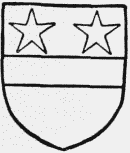
Poer. Gules a fesse or with two molets or in the chief.
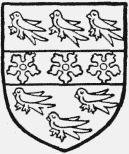
Washbourne. Argent a fesse between six martlets gules with three cinqfoils argent on the fesse.
It would seem that the manor passed to his son and heir William during his lifetime, for in September 1695 William Washbourne the younger made it over to George Dowdeswell for five years at a peppercorn rent in return for the latter's services in helping him meet debts amounting to £800. (fn. 58) Three months later George Dowdeswell leased the manor and its appurtenances to William Rider for three years at a yearly rent of £108. (fn. 59) William Washbourne sold the manor in 1712 to Edmund Skinner. (fn. 60) The latter was Sheriff of Worcestershire in 1726. (fn. 61) He was succeeded by a daughter, Anna wife of Plukenett Woodroffe, on whose death in 1787 the manor passed to her third but eldest surviving son Skynner Woodroffe. (fn. 62) He died in 1822, and was succeeded by his brother George, who, dying in the same year, was followed by his son Skynner George. (fn. 63) The latter was succeeded on his death in 1848 by his son George William Plukenett, (fn. 64) who sold Wichenford Court about 1856 to Daniel Britten. (fn. 65) Rear-Admiral Richard Frederick Britten, J.P., son and successor of Daniel Britten, died in 1910, and the manor now belongs to his widow, the Hon. Mrs. Britten.
An estate called WYARDS (fn. 66) or WYARDS WOODHALL in Wichenford seems to have consisted of a yardland held of the Bishop of Worcester in the manor of Wichenford by the widow of John Wyard in 1299. (fn. 67) By an undated deed Robert son of Robert Wyard gave to Robert de Cowsden 3 acres of land held by Walter son of Walter the Miller in la Buriende in the vill of Wichenford, to be held of Robert Wyard for the rent of a rose. (fn. 68) Stephen Wyard acquired land in Wichenford from William Habington, but the date of this transaction is not known. (fn. 69) In 1320–1 Thomas Habington owned for a messuage called the Hawe Place suit of court and heriot to the manor of Wyards Woodhall. (fn. 70) John Wyard forfeited all his possessions in 1322 for his adherence to Roger de Mortimer Earl of March, (fn. 71) and in 1323 Woodhall was granted to Simon de Reding, king's serjeant-at-arms, for life. (fn. 72) Free warren at Woodhall was granted to Simon in the following year. (fn. 73) John Wyard was pardoned, and his lands were restored to him in 1331, (fn. 74) and in the same year he conveyed to John de Stone and Joan his wife his manor of Woodhall. (fn. 75) This conveyance must have been made for the purpose of some settlement, for the estate passed from John Wyard to his daughter Elizabeth, who married William de la Lowe. (fn. 76) Richard de la Lowe, her son, (fn. 77) sold to William Habington in 1417–18 all his lands called Wyards Woodhall. (fn. 78) This is probably the William Habington of the pedigree in the Worcester Visitation of 1569 called 'of Wichenford.' (fn. 79) His descendant of the same name was in possession of a house lately belonging to John Wyard at Wichenford in 1519–20, (fn. 80) and Richard son of William Habington held a house or mill called Wyards in Wichenford. (fn. 81) The further descent of this estate is identical with that of the manor of Woodend (fn. 82) (q.v.) until 1628. It was then called the manor of Wyors. (fn. 83)
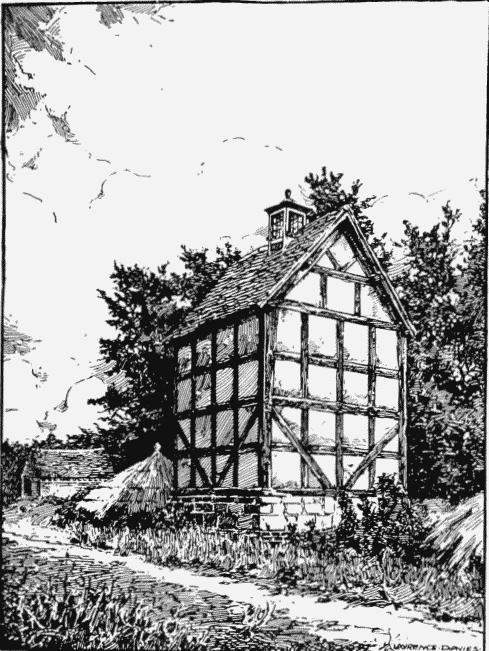
Dovecote at Wichenford Court
An estate subsequently known as the manor of WOODEND or HABINGTONS PLACE in Wichenford, held of the see of Worcester, (fn. 84) apparently consisted of a quarter of a yardland in Wichenford held by Nicholas Attwood or de Boys in 1299. (fn. 85) There was a monument without date to John de Boys, lord of Wichenford, in the church of Hindlip, (fn. 86) and John Gannon and Margery his wife by an undated conveyance sold certain lands in the manor of Wichenford, of the fee of Nicholas de Boys, to William Habington and Margery his wife. (fn. 87) This William Habington was of Bedwardine, co. Worcester, and, according to Habington, had obtained an estate at Wichenford before 1286 by his marriage with Margery daughter of William Beaufitz of Eastleach, co. Gloucester, by Margery daughter and co-heir of Richard Wood of Wichenford. (fn. 88) William Habington held a yardland at Wichenford in 1299. (fn. 89) The estate descended in the Habington family, (fn. 90) of whom a doubtful pedigree is given in the Visitation of Worcester of 1569, (fn. 91) until the death of Richard son of Richard Habington in 1545. Richard left his co-heirs three daughters, (fn. 92) Mary wife of Richard Barneby of Acton in the parish of Ombersley, co. Worcester, Jane wife of Edward Stamford of Rowley, co. Staff., and Eleanor married first to John Dancey, secondly to Sir Thomas Baskerville of Brinsop, co. Hereford, (fn. 93) and thirdly to John Gage. It appears that the manor had been settled by Richard Habington, grandfather of these co-heirs, upon his son Richard in tail-male with contingent remainders to his other sons George, Edward and John. On the death of Richard Habington the son, John his only surviving brother laid claim to the manor, but it does not seem that he was ever able to establish his right, (fn. 94) though he subsequently acquired the third of the manor held by Edward Stamford in right of his wife Jane in 1565. (fn. 95) John Habington died in 1581, (fn. 96) and his sons Thomas and Richard conveyed this portion of the manor in 1596 to John Talbot. (fn. 97) Robert Barneby, son of Richard Barneby and Mary Habington, (fn. 98) sold his third of the manor to John Steyner of Worcester, (fn. 99) and the history of this third has not been further traced. Eleanor the third daughter of Richard Habington had issue by Sir Thomas Baskerville, a daughter Eleanor, who married the above-mentioned John Talbot, (fn. 100) and in 1599 John and Eleanor Talbot conveyed two thirds of the manor, one which John had acquired by purchase from the Habingtons and the other, of which it would seem they held only the reversion, to Eleanor Talbot's mother Eleanor, who was then the widow of John Gage. (fn. 101) These two thirds of the manor passed from Eleanor to Edward Gage her son by her third husband. (fn. 102) He died in 1628 holding two thirds of the manor of Wyors and two thirds of land in Wichenford, leaving a son and heir William, (fn. 103) who conveyed a third of the manor of Wichenford in 1653 to Augustine Belston and William Nevill. (fn. 104) Nash states that the Gages long enjoyed this estate and sold some of it to Mr. Gyles, a clothier in Worcester, whose estate is called 'the Wooden Farm.' (fn. 105)
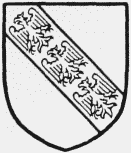
Habington of Woodend. Argent a bend gules with three eagles or thereon.
Another estate in Wichenford is mentioned in 1530, when William Mucklowe died, owning the so-called manor of Wichenford, which he had previously settled on his wife Margery. (fn. 106) Richard was his son and heir, and was then aged thirty. (fn. 107) Richard died in 1556, (fn. 108) and the estate evidently passed to his son and heir Simon, for a little later Lettice wife of John Page, daughter of Richard Mucklowe, claimed against Simon a share of the manor, which, she said, under the will of her father, ought to have been divided amongst his seven children. (fn. 109) Habington in his survey gives the following account of it: 'Leyke's armory maye showe howe Leyke deryvethe hys tytell to thease landes which after they inioyed tyll Leyke sould the same to Mr. Richard Mucklowe, whose heyre in our age dispersed by sale thease possessyons amounge others.' (fn. 110) Nash continues the history of this estate: 'One parcel was purchased by Mr. Andrews, who sold it to Mr. Nash, whose only daughter Elizabeth married John Moulding, a very ingenious antiquary.' (fn. 111)
The Prior and convent of Worcester held certain lands at Wichenford, probably included at the Dissolution in the manor of 'St. Jonys cum Wichenford.' (fn. 112) These lands were granted to the Dean and Chapter of Worcester in 1542. (fn. 113)
In an undated deed, probably of the 13th century, Walter son of Walter the Miller of la Buriende in Wichenford is mentioned. (fn. 114) In 1545 a water-mill belonged to Richard Habington's manor of Wichenford, (fn. 115) and in 1787 two mills were annexed to the Woodroffes' manor there. (fn. 116) In 1636 it was presented at the county court that George Sherwood of Wichenford ought to repair part of Blackmore Bridge over the River 'Lawrne,' lying in Wichenford parish, by reason of the tenure of his mill there. (fn. 117) The present Woodhall Mill on Laughern Brook, now in the parish of North Hallow, is probably the successor of Habington's mill. There are no mills in the parish of Wichenford at the present day.
CHURCH
The church of ST. LAWRENCE consists of a chancel measuring internally 27¾ ft. by 16½ ft., a north vestry, a nave 49 ft. by 21½ ft., a west tower 10 ft. wide and a south porch.
The nave is the oldest part of the present church and dates from about 1320. The east part of the contemporary chancel has been rebuilt in modern times. The present tower was added at the end of the 14th century, the original west wall of the nave being removed. In 1791 the steeple was removed as being unsafe, and in 1863 the upper part of the tower was rebuilt and a new spire added. There is some evidence of the existence of a 12th-century church in the capitals of that date preserved at the rectory.
The modern east window is of three lights. The side walls are each pierced by two lancets, all of 13th-century date, except that on the north-east, which is modern. In the south wall are a 13th-century door and a piscina. The chancel arch is modern. In the north wall of the early 14th-century nave are three modern two-light windows, one replacing the north door. The tower arch has two massive orders springing from chamfered abaci. In the north and south walls of the ground stage are single ogee lights. The west window is also a single light; the door beneath it is modern. The south door of the nave and the porch are modern. To the east of the south door is a two-light window with a quatrefoil over of the 14th century. The south-west window of the nave is a single light of the same date with a restored head. At the south-east is a contemporary trefoiled piscina.
The roofs and fittings are modern. In the south-west corner of the nave is a tomb with two recumbent effigies, to John Washbourne, who died in 1615, and Alice his wife and their three children. The inscribed slab above has been replaced by a brass plate. Mounted on a board close to the tower arch are the old clappers of the bells, which have recently been fitted with new ones.
On the north side of the chancel is an altar tomb with two effigies in 17th-century armour, one on the slab and one beneath it. Behind are two female figures kneeling in recesses, with a classic cornice and ornament above crudely coloured and gilt. An inscription records that John Washbourne at the age of eighty-four built the monument for himself (the upper figure), his two wives Mary Savage and Eleanor Lygon, and his father Anthony (the lower figure).
There are four shields, the centre and highest one of the Washbourne arms. Below this is a shield quarterly of Washbourne quartered with Poer and Dabitot. To the west is a shield of these arms impaling the six lions of Savage. To the east is the same impaling the two lions passant of Lygon.
On the north side of the chancel is an alabaster slab used as a credence and fitted to the sill of a window. It is stated to have been found in the rectory garden and probably formed the top of an altar tomb.
There are three bells, (fn. 118) the first and third by John Martin of Worcester, dated respectively 1673 and 1664, but only the third has his foundry mark. The second is a mediaeval bell inscribed '+ Sancte Michael Ora Pro Nobis,' with fleur de lis and head of Prince Edward (son of Henry VI) as stops; on the shoulder is an inscription in smaller letters of a similar character to those at Lindridge, 'Tempore Dñi Thome Feld,' with similar stops. Thomas Feld was vicar until 1489, and the bell was cast at Worcester about 1480.
The plate consists of an early Elizabethan cup with a leaf band under the rim and a thistle below and a cover paten with a pricked band ornamentation, both being without hall marks. There are also a large flat paten, made in 1747, and presented by Plukenett Woodroffe in 1748, and a modern plated flagon.
The registers (fn. 119) previous to 1812 are as follows: (i) mixed entries 1690 to 1788, marriages stopping at 1754 (an earlier book beginning 1539 is recorded by Nash, but is known to have been missing since 1847): (ii) baptisms and burials 1788 to 1812; (iii) a marriage book 1754 to 1812.
ADVOWSON
A church or chapel (fn. 120) has existed at Wichenford from early times. The chapel of Wichenford, which was attached to the church of St. Helen, Worcester, was granted by the monks after the death of Bishop Wulfstan to Fritheric, the priest of St. Helen's, who was to make provision for them during his lifetime. After his death all the possessions which he held in trust for the monks were to return to the prior and convent. (fn. 121) In 1234 a division was made of the chapelries annexed to St. Helen's, between the Bishop and the Prior and convent of Worcester. Wichenford, as lying on the west bank of the Severn, fell to the share of the prior and convent, (fn. 122) who presented to the vicarage until the dissolution of their house. (fn. 123)
The advowson of Wichenford was evidently granted to the Dean and Chapter of Worcester, though no record of this grant has been found, (fn. 124) for the presentations from 1573 until the present day have been made by the dean and chapter. (fn. 125)
The surveys taken at the time of the dissolution of the chantries in the reign of Edward VI mention a piece of land in this parish worth 3s. 4d. a year which had been given to maintain an obit light in the parish church of Wichenford. (fn. 126) This land was leased to William Dalby in 1560, (fn. 127) but after that date all trace of it is lost.
An image of St. Michael the Archangel in the chancel of Wichenford Church is mentioned in the will of John Washbourne dated 1532, (fn. 128) and John Washbourne, by will dated 1517, bequeathed his body to be buried in the chancel of St. Michael in Wichenford and 40d. to the high altar of St. Michael at Wichenford. (fn. 129)
CHARITIES
The gifts of William Evett and other donors, including a legacy of £20 by will of Mrs. Ann Groves, proved at Worcester 12 February 1814, amounting together to £86, as recorded on the church table, were with other benefactions invested in the purchase of £178 1s. 10d. consols. The annual dividends, amounting to £4 9s., are distributed in money doles.
The Rev. John Pritchett and Mrs. Pritchett, the relict, by their respective wills (date not stated), bequeathed legacies of £100 and £100, the interest to be applied annually in clothing two poor old men and two poor old women.
The two legacies, less duty, were in 1857 invested in £196 14s. 5d. consols, producing yearly £4 18s. 4d., which is duly applied.